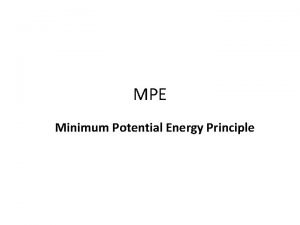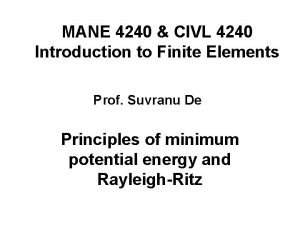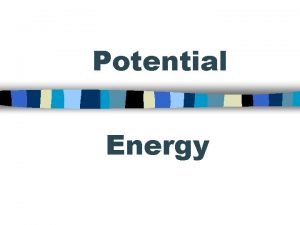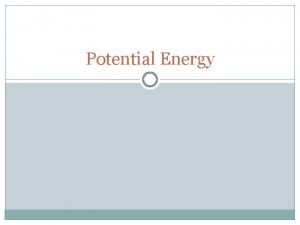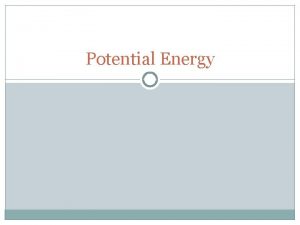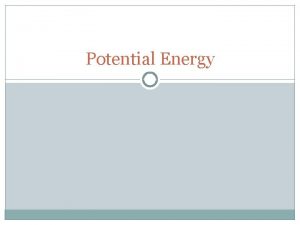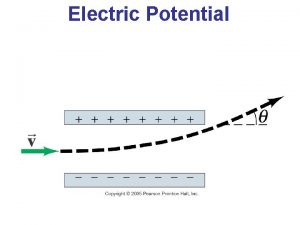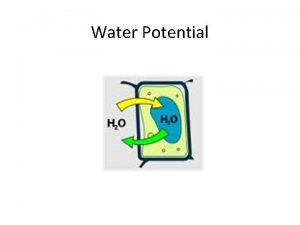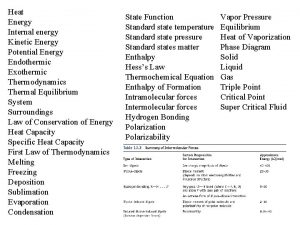MPE Minimum Potential Energy Principle MPE Principle For

















- Slides: 17

MPE Minimum Potential Energy Principle

MPE Principle • For conservative structural systems, of all the kinematically admissible deformations, those corresponding to the equilibrium state extremize(i. e. , minimize or maximize) the total potential energy. If the extremum is a minimum, the equilibrium state is stable.

MPE • A constrained structural system, i. e. , a structure that is fixed at some portions, will deform when forces are applied on it. Deformation of a structural system refers to the incremental change to the new deformed state from the original undeformed state. The deformation is the principal unknown in structural analysis as the strains depend upon the deformation, and the stresses are in turn dependent on the strains.

MPE • Therefore, our sole objective is to determine the deformation. The deformed state a structure attains upon the application of forces is the equilibrium state of a structural system. The Potential energy (PE) of a structural system is defined as the sum of the strain energy (SE) and the work potential (WP).

MPE • PE = SE +WP---------------1 • The strain energy is the elastic energy stored in deformed structure. It is computed by integrating the strain energy density (i. e. , strain energy per unit volume) over the entire volume of the structure.

MPE

MPE • The work potential WP, is the negative of the work done by the external forces acting on the structure • Work done by the external forces is simply the forces multiplied by the displacements at the points of application of forces.

MPE • Thus, given a deformation of a structure, if we can write down the strains and stresses, we can obtain SE, WP, and finally PE. • For a structure, many deformations are possible. For instance, consider the pinned-pinned beam shown in Figure 1 a. It can attain many deformed states as shown in Figure 1 b. But, for a given force it will only attain a unique deformation to achieve equilibrium as shown in Figure 1 c.

MPE • What the principle of MPE implies is that this unique deformation corresponds to the extremum value of the MPE. In other words, in order to determine the equilibrium deformation, we have to extremize the PE. The extremum can be either a minimum or a maximum. When it is a minimum, the equilibrium state is said to be stable. The other two cases are shown in Figure 2 with the help of the classic example of a rolling ball on a surface.

MPE

MPE

Application of MPE • Consider the simplest model of an elastic structure viz. a mass suspended by a linear spring shown in Figure 3. We would like to find the static equilibrium position of the mass when a force F is applied. We will first use the familiar force-balance method, which gives

Application of MPE

Application of MPE • We can arrive at the same result by using the MPE principle instead of the force-balance method. Let us first write the PE for this system.

Application of MPE

Application of MPE

Application of MPE • For the assumed values of k = 5, and F = 10, equilibrium deflection is 2 which is consistent with Figure 4. in above slide.
 Minimum potential energy
Minimum potential energy Minimum potential energy
Minimum potential energy Electrostatic potential difference
Electrostatic potential difference Potential energy of capacitor
Potential energy of capacitor V = pe/q
V = pe/q Absolute max vs local max
Absolute max vs local max Energy formula
Energy formula Gravity and kinetic energy
Gravity and kinetic energy Chemical energy
Chemical energy Energy is the ability to
Energy is the ability to Gravitational potential energy vs kinetic energy
Gravitational potential energy vs kinetic energy Kinetic potential
Kinetic potential Potential enrgy
Potential enrgy Potential energy of spring
Potential energy of spring Potential energy
Potential energy Potential energy units
Potential energy units Flaccid cell
Flaccid cell Osmotic potential
Osmotic potential
